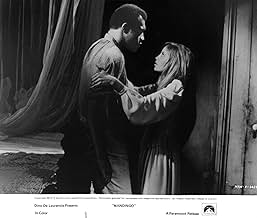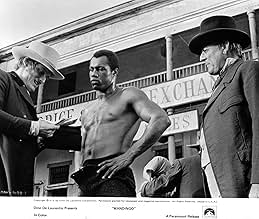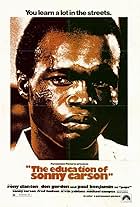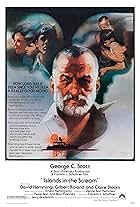- Awards
- 1 win total
Debbi Morgan
- Dite
- (as Debbie Morgan)
- Director
- Writers
- All cast & crew
- Production, box office & more at IMDbPro
Featured reviews
This unflinching, hard-hitting look at slavery is a severely underrated and misjudged film. That's probably because it sheds light onto a tough, painful subject that many people would prefer to ignore or forget; if you're expecting a "slaves-and-masters-are-all-a-big-happy-family" depiction of the life in the mid-19th-century Southern plantations, then this simply isn't your movie.
"Mandingo" was followed, one year later, by "Drum". They are both far better films than their reputations might make you believe, and they are also handsome, almost sumptuous productions with a far lower "sleaze" quotient than many reviews seem to indicate. They are both worth seeing - preferably as a double bill. (***)
"Mandingo" was followed, one year later, by "Drum". They are both far better films than their reputations might make you believe, and they are also handsome, almost sumptuous productions with a far lower "sleaze" quotient than many reviews seem to indicate. They are both worth seeing - preferably as a double bill. (***)
I can see why this was controversial, and no doubt it would be if it were released now (2013). It's stunningly unlike Gone with the Wind. The style is extreme Southern Gothic, (not to be confused with camp). Some shades of Tennessee Williams but goes beyond where he dared. The dialogue is a bit difficult, and DVD has no English subtitles, but you'll be rewarded if you stick with it. (No need to understand every word). I agree that Tarantino was influenced by it but his approach to the subject matter is very different. Mandingo stands on its own as a major work of the 1970s and it's certainly a film that deserves to be better known. Striking photography and music throughout. This film panders to no one, nor does it simplistically tell the viewer what to think about anything. We have the feeling we're on our own with this. Maybe it's no accident that that feels liberating. Fasten your seat belts and see it.
1975's "Mandingo" earned much scorn from such highbrow critics as Roger Ebert, such was its unflinching look at slave relations in the Antebellum South, including numerous interracial couplings featuring full frontal nudity. The series of Falconhurst novels began with Kyle Onstott's original 1958 publication of "Mandingo," named for a specific type of fighter from the West African Niger region, also known for its later use by Alex Haley in his largely fictional yet compelling family history "Roots," the miniseries still two years away from its debut broadcast. Producer Dino De Laurentiis spent a number of years trying to finalize a deal, and with the relaxation of the old ratings system could never have filmed such a sordid tale until the 70s, a decade of untold exploitation where 'anything goes,' and often did. Director Richard Fleischer initially turned the assignment down but finally relented, James Mason earning top billing as plantation owner Warren Maxwell, in a role rejected by James Cagney and Charlton Heston, Perry King as son Hammond in place of Jan-Michael Vincent, Jeff Bridges, Beau Bridges, and Timothy Bottoms. Hammond is mostly portrayed as a sympathetic figure toward his slaves, often at odds with his harder edged father, his subsequent marriage to cousin Blanche (Susan George) soured on their wedding night by her less than virginal countenance under the sheets (as was so often the case, the girl was deflowered by her own brother). Hammond's purchase of new 'bed wench' Ellen (Brenda Sykes) does not go unnoticed by an increasingly irrational Blanche, eventually taking revenge on her faithless spouse by summoning Mandingo fighter Mede (Ken Norton) to her bed, producing a non white child that is quietly allowed to bleed to death, poor Blanche poisoned and defenseless Mede shot, scalded, and butchered by pitchfork. Critics were appalled by the brutality of Norton's no holds barred fight scenes, and the nihilistic climax left audiences appropriately stunned, a game cast putting forth a great effort to bring such unhappiness to vivid life. Interiors are effectively dark and gloomy, furniture sparse and guests rarely in evidence, slaves variously bought and sold to keep the rundown plantation afloat (location shooting in Louisiana). Susan George gives an uncanny rendition of Bette Davis in a part that few actresses would brave, and even at the end still earns sympathy making tearful entreaties to her unfeeling husband. James Mason and Perry King also acquit themselves well, as does Richard Ward as the intelligent Agamemnon punished for being able to read, and Ji-Tu Cumbuka, later Kunta Kinte's Wrestler on ROOTS, making the strongest impression as a runaway slave who prefers death to a life enchained. Personal preference impacts how one sees this picture, slowly gaining increased stature over the years, and certainly better than its immediate sequel "Drum," Ken Norton returning as a new character.
10Don-94
I just saw this film on the big screen (the only surviving 35mm print in the world). I had never seen it on video, so seeing it in a crowded theater was my first experience with the film. As a bonus, the director, Richard Fleischer, the star, Perry King, and Brenda Sykes, who plays King's slave "wench" in the film, spoke before the screening.
The audience alternated between gasping and roaring with immediately regretted laughter throughout the screening. Nobody laughed for a moment at Susan George's supposedly over-the-top performance. And at the climax -- there were astounded gasps all over the theater. Afterwards, once the applause had died down, the audience filed out, stunned. Everyone looked shell-shocked. I wandered around for a while listening to people murmuring: "I told you guys..." "Best I've seen..." "Totally uncompromising..." "That's how it was..." "Didn't pull any punches..." "Amazing..." "Where did you hear about it?..."
We had one big advantage over most people who see the film. Most viewers go rent the tape because they read about it in, say, Edward Margulies' and Stephen Rebello's BAD MOVIES WE LOVE (which is how I knew about it). MANDINGO has a huge reputation as a camp classic, so people seek out the video where it can be found. Then they take it home and watch it alone, or with a friend or two, pre-primed to laugh.
The audience I was sitting with at the American Cinematheque theater had, first of all, read the sober, favorable description in the Cinematheque schedule. Then we'd listened to Fleischer himself talk about how he had refused ten times when Dino de Laurentiis had asked him to film the novel, only to finally accept when he realized how he could do it: "By being totally honest and straight with it." And he was, if you view it without a laugh ready. King and Sykes also spoke calmly and soberly about how hard the shoot was, and how the cast considered it an important film but still had trouble handling the emotions it stirred up.
Fleischer is hardly a symbolic director, although there's a lot of "found" symbolism in 10 RILLINGTON PLACE, for example. But MANDINGO was an obvious statement of the inhumanity of slave-OWNing, and it constantly used the setting and characters to emphasize the moral and physical disintegration of the Deep South under the self-imposed yoke of the slave culture. That sounds pretentious, but in MANDINGO it's totally straightforward. Moral disintegration leads to moral disintegration. The crime is its own punishment. MANDINGO is an antimatter GONE WITH THE WIND.
MANDINGO, as Fleischer pointed out, was a huge hit on its initial release. It was also viciously attacked by all but two critics in the United States. (Fleischer admitted that he saved all his reviews, and pointed out mildly that those two reviewers -- who were the only critics to go into the film in depth -- pronounced the film a masterpiece. "I don't know if it's that," he said, "but those two were certainly a breath of fresh air.")
Because of all the controversy, the film was never rereleased. Nobody at the screening could think of a single time it had been screened between 1975 and August 28, 1999. Perhaps it was screened once or twice, but my point is that essentially no one since 1975 has seen this film with an audience, to feel the reactions of those around the room, to see it on the big screen.
I think it's really unfortunate that MANDINGO has gotten locked into this "camp" label. The film contains so much depravity that I can certainly see why it was selected as a "camp classic". But that wasn't the intent at all. I've heard this film compared to SHOWGIRLS. But SHOWGIRLS was directed by the bizarre Paul Verhoeven (ROBOCOP, TOTAL RECALL, BASIC INSTINCT). Of course he was going for camp; he always does camp. But Richard Fleischer? He did 20,000 LEAGUES UNDER THE SEA, MR. MAJESTYK, 10 RILLINGTON PLACE (a real gem), THE BOSTON STRANGLER, FANTASTIC VOYAGE, SOYLENT GREEN. He is one of the most mild-mannered directors alive. He's done bad stuff -- CONAN THE DESTROYER and RED SONJA come to mind -- but in the seventies he was doing his best work. And that would have to include MANDINGO -- to my complete amazement.
I can't believe how different my experience with this film was from its usual "cult" interpretation. Now I wonder if Otto Preminger's HURRY SUNDOWN is as bad as the Medveds said it was in 50 WORST FILMS OF ALL TIME. I'll have to try to see it for myself.
The audience alternated between gasping and roaring with immediately regretted laughter throughout the screening. Nobody laughed for a moment at Susan George's supposedly over-the-top performance. And at the climax -- there were astounded gasps all over the theater. Afterwards, once the applause had died down, the audience filed out, stunned. Everyone looked shell-shocked. I wandered around for a while listening to people murmuring: "I told you guys..." "Best I've seen..." "Totally uncompromising..." "That's how it was..." "Didn't pull any punches..." "Amazing..." "Where did you hear about it?..."
We had one big advantage over most people who see the film. Most viewers go rent the tape because they read about it in, say, Edward Margulies' and Stephen Rebello's BAD MOVIES WE LOVE (which is how I knew about it). MANDINGO has a huge reputation as a camp classic, so people seek out the video where it can be found. Then they take it home and watch it alone, or with a friend or two, pre-primed to laugh.
The audience I was sitting with at the American Cinematheque theater had, first of all, read the sober, favorable description in the Cinematheque schedule. Then we'd listened to Fleischer himself talk about how he had refused ten times when Dino de Laurentiis had asked him to film the novel, only to finally accept when he realized how he could do it: "By being totally honest and straight with it." And he was, if you view it without a laugh ready. King and Sykes also spoke calmly and soberly about how hard the shoot was, and how the cast considered it an important film but still had trouble handling the emotions it stirred up.
Fleischer is hardly a symbolic director, although there's a lot of "found" symbolism in 10 RILLINGTON PLACE, for example. But MANDINGO was an obvious statement of the inhumanity of slave-OWNing, and it constantly used the setting and characters to emphasize the moral and physical disintegration of the Deep South under the self-imposed yoke of the slave culture. That sounds pretentious, but in MANDINGO it's totally straightforward. Moral disintegration leads to moral disintegration. The crime is its own punishment. MANDINGO is an antimatter GONE WITH THE WIND.
MANDINGO, as Fleischer pointed out, was a huge hit on its initial release. It was also viciously attacked by all but two critics in the United States. (Fleischer admitted that he saved all his reviews, and pointed out mildly that those two reviewers -- who were the only critics to go into the film in depth -- pronounced the film a masterpiece. "I don't know if it's that," he said, "but those two were certainly a breath of fresh air.")
Because of all the controversy, the film was never rereleased. Nobody at the screening could think of a single time it had been screened between 1975 and August 28, 1999. Perhaps it was screened once or twice, but my point is that essentially no one since 1975 has seen this film with an audience, to feel the reactions of those around the room, to see it on the big screen.
I think it's really unfortunate that MANDINGO has gotten locked into this "camp" label. The film contains so much depravity that I can certainly see why it was selected as a "camp classic". But that wasn't the intent at all. I've heard this film compared to SHOWGIRLS. But SHOWGIRLS was directed by the bizarre Paul Verhoeven (ROBOCOP, TOTAL RECALL, BASIC INSTINCT). Of course he was going for camp; he always does camp. But Richard Fleischer? He did 20,000 LEAGUES UNDER THE SEA, MR. MAJESTYK, 10 RILLINGTON PLACE (a real gem), THE BOSTON STRANGLER, FANTASTIC VOYAGE, SOYLENT GREEN. He is one of the most mild-mannered directors alive. He's done bad stuff -- CONAN THE DESTROYER and RED SONJA come to mind -- but in the seventies he was doing his best work. And that would have to include MANDINGO -- to my complete amazement.
I can't believe how different my experience with this film was from its usual "cult" interpretation. Now I wonder if Otto Preminger's HURRY SUNDOWN is as bad as the Medveds said it was in 50 WORST FILMS OF ALL TIME. I'll have to try to see it for myself.
This film, despite some controversy about it's biracial sex scenes when it was initially released, seems to have faded from memory. Given the degree of sex, violence, and unadulterated exploitation of slavery in the antebellum South, that's a surprise, because I saw this flick nearly ten years ago and STILL can't forget it! Those whose image of the old South has forever been defined by GONE WITH THE WIND as romantic and chivalrous and pick up this movie in the video store(the cover art on the box resembles that famous pose with Gable and Leigh)thinking they're about to be trasported to Tara ought to run like Hell! James Mason and his lame son Perry King live on a plantation and own slaves body and soul. Well, at least the body part, as we see when Mason strings an errant slave upside down, strips him, and pattles his butt with a perforated paddle. Son King takes a more tender approach, as he sleeps with the female slaves, especially Brenda Sykes, whom he takes as his mistress. However, he marries Susan George to provide an heir, and presents her with a ruby choker. He also gives Sykes the matching earrings. When George learns of the relationship(Sykes wears the earrings while she serves dinner to George and King on their first night at the plantation), and Kings learns George has slept with her brother, the marriage hits the skids. George drowns her sorrows in lots of sherry and lots of Ken Norton, a slave Perry has purchased specifically for fighting other slaves for betting. George becomes pregnant, and when the baby comes, it hits the fan! It's hard to believe that anyone in 1975 could see this film as anything but exploitation of a very dark period in American history. Didn't anyone cringe at the sight of King going in to "take pleasure" from a female slave in a bed and the woman groans, "I too black for you", or Ken Norton standing stoically on the auction block of a slave sale while an old woman gropes around inside his loincloth? The video edition of this film I saw was from the early eighties, when movie studios did their transfers from the first worn-out prints the could grab, and may have had a muddy, faded look because of this, but it's hard to believe this thing came from a major studio. You'd certainly wouldn't know it from the production values, because the film looks as if the filmmakers didn't spend a penny more than they had to(we're treated to interior scenes inside a plantation house curiously devoid of furniture). With all these setbacks, it's hard to understand why this movie hasn't garnered even a semi-cult following. If you're in the mood to be offended on all levels and don't treasure some romanticized Hollywood image of the old South, grab MANDINGO.
Storyline
Did you know
- TriviaJames Mason admitted in interviews that he only made the film to make his alimony payments.
- GoofsDuring Mede's first fight in the city, he and his opponent are wrestling on the grass. When they roll over on the floor, the grass moves like a slipping carpet would, revealing it to be a sheet of artificial green, probably lying on the floor of a sound stage.
- Alternate versionsThe international version of the film (released on PAL region 2 DVD) contains a different cut of the film that runs approx. 5 minutes shorter than the U.S. release but also has many scenes presented in alternate clothed takes. In all 12 scenes were either trimmed or re-edited with alternate shots/angles/takes:
- Scene where slave is bent over and inspected for hemorrhoids is cut.
- Scene where the wench is being prepared for her deflowering is presented in an alternate take where her breasts are not exposed.
- Scene with pregnant wench is shot with alternate angles to obscure nudity. Perry King's full frontal nudity is cut and replaced with a closer shot that reveals he is wearing shorts when he kneels down to pray (It looks like a goof - only a bit of the waistband can be seen at the corner of the frame).
- Alternate takes of the slave being strung up to be beaten are used to obscure nudity, and many shots of him being beat and left bloody are cut.
- A few seconds where Perry King's cousin rips off a wench's dress and bends her over to begin beating her is cut to remove nudity. The beating is left intact.
- The slave market scene is edited to remove the topless wenches on display, and the shot where the German widow sticks her hand into Ken Norton's shorts and "inspects" him is cut short. The second shot with her hand in and then removing it is left intact though.
- An alternate take is used with a prostitute clothed rather than nude at the bawdy house.
- A few seconds of a prostitute rubbing on Perry King's crotch is cut.
- An alternate take is used during the fight at the bawdy house so that a prostitute is seen holding her dress up while she cheers whereas in the original she lets it fall and her breasts be exposed.
- The entire scene between Perry King and Brenda Sykes in which she asks him if he'll let their child go free is presented in alternate clothed takes. In the original film they are both completely nude. Even the camera angles and setups are the same, only with clothes in the international version.
- In the scene where Ken Norton fights a man to death one long shot where the other fighter claws his back is cut. Also cut is when Ken bites down on the other fighter's neck, is pulled off, and then bites into his neck again. All the close-ups are cut.
- The Susan George/Ken Norton love scene is almost entirely missing. Ken Norton's nudity is cut, and then the scene ends in an alternate take when the two go out of frame onto the bed. The original scene went on for much longer and exposed Ken Norton's buttocks and Susan George's breasts. The German theatrical version does not feature any of these alterations and is identical to the U.S. release.
- ConnectionsFeatured in Sooner or Later (1979)
- SoundtracksBorn in This Time
Music by Maurice Jarre
Lyrics by Hitide Harris (as Hi Tide Harris)
Sung by Muddy Waters
[Played during opening title and credits]
Details
- Release date
- Country of origin
- Languages
- Also known as
- Bitmeyen Kavga
- Filming locations
- Production companies
- See more company credits at IMDbPro
Box office
- Gross US & Canada
- $2,433,010
- Runtime2 hours 7 minutes
- Sound mix
- Aspect ratio
- 1.85 : 1
Contribute to this page
Suggest an edit or add missing content



































